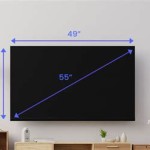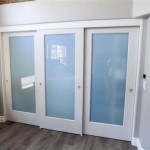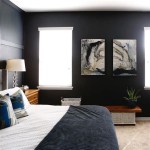Selecting Large Picture Art for Bedroom Walls
The selection of appropriate artwork for a bedroom environment contributes significantly to the overall ambiance and perceived comfort of the space. A large picture, strategically chosen and positioned, can serve as a focal point, influencing the room's aesthetics and promoting a sense of calm and well-being. The process of selecting such a piece involves careful consideration of several factors, including the room's existing décor, the desired mood, and the artwork's size, style, and color palette. This article will explore key considerations when choosing large picture art for bedroom walls.
Size and Scale Considerations
Determining the appropriate size of the artwork is paramount. A picture that is too small risks being visually lost on a large wall, while one that is too large can overwhelm the space and create a feeling of imbalance. A common rule of thumb is to select a piece that covers approximately two-thirds to three-quarters of the available wall space. This measurement should be taken horizontally, especially if the picture is intended to be placed above a bed or other piece of furniture. The vertical dimension is equally crucial; the picture should be proportionally sized relative to the height of the wall and the furniture beneath it. Failing to adhere to these principles can result in an artwork appearing disproportionate and detracting from the overall aesthetic appeal of the room.
Before committing to a purchase, it is advisable to use painter's tape to mark out the potential dimensions of the artwork on the wall. This allows for a visual representation of the size and helps in assessing its suitability within the space. Furthermore, consider the viewing distance. A highly detailed artwork may benefit from being viewed from a closer range, which might necessitate a smaller size if the room's layout does not permit sufficient distance. Conversely, a more abstract piece or one with bold, simple lines can be larger as its impact remains effective even when viewed from afar.
The height at which the picture is hung also affects the perceived size. A common guideline is to hang artwork so that its center is at eye level, typically around 57 to 60 inches from the floor. However, adjustments may be necessary depending on the size of the artwork and the height of the ceiling. If the picture is hung above a piece of furniture, such as a bed or a dresser, leave approximately 6 to 12 inches between the bottom of the artwork and the top of the furniture. This gap ensures visual separation and prevents the artwork from appearing to be attached to the furniture.
Style and Subject Matter Harmony
The style and subject matter of the artwork should complement the existing décor of the bedroom. A modern bedroom, characterized by clean lines and minimalist furnishings, might benefit from abstract art, geometric patterns, or black and white photography. These styles often enhance the sense of simplicity and sophistication that defines modern design. In contrast, a more traditional bedroom, featuring ornate furniture and classic patterns, may be better suited to landscape paintings, portraits, or still life art. These styles often evoke a sense of history and elegance, harmonizing with the traditional aesthetic.
Beyond the overall style, the specific subject matter can influence the mood and atmosphere of the room. Images of nature, such as serene landscapes, calming seascapes, or lush forests, are often favored for bedrooms due to their ability to promote relaxation and tranquility. These scenes can evoke a sense of peace and escape, making them ideal for a space intended for rest and rejuvenation. Conversely, more dynamic or abstract subject matter, while potentially visually striking, may be less conducive to a restful environment, particularly if the colors are very intense. Consider the overall feeling one wants to create in the bedroom and select artwork accordingly.
Personal preference plays a significant role in the selection process. The artwork should resonate with the individual, reflecting their tastes and interests. This ensures that the piece is not only aesthetically pleasing but also personally meaningful. It is advisable to avoid trends or styles that are not genuinely appreciated, as these may quickly become outdated or tiresome. Choosing artwork that is personally meaningful enhances the connection to the space and fosters a deeper sense of comfort and belonging.
It is also important to consider the relationship between the artwork and the existing color palette of the bedroom. The artwork can either complement the colors already present or serve as a contrasting accent. A complementary color scheme involves selecting artwork that features colors that are similar to those used in the room's décor. This creates a harmonious and cohesive look. A contrasting color scheme, on the other hand, involves selecting artwork that features colors that are opposite on the color wheel from those used in the room's décor. This creates a more dynamic and visually stimulating effect. Regardless of the approach, it is crucial to ensure that the colors in the artwork work well with the overall color scheme of the room.
Materiality, Framing, and Lighting Effects
The materiality of the artwork, including the canvas, paper, or other substrate, and the frame, if present, significantly impacts its overall appearance and durability. Choosing high-quality materials ensures that the artwork will withstand the test of time and maintain its visual appeal. For instance, canvas prints, often used for reproductions of paintings, should be made from high-quality cotton or linen to prevent sagging or warping. Similarly, paper prints, such as photographs or posters, should be printed on archival-quality paper to prevent fading or discoloration.
The choice of frame can either enhance or detract from the artwork. A well-chosen frame complements the artwork and its surrounding environment, while a poorly chosen frame can overwhelm the piece or clash with the room's décor. The frame should be proportional to the size of the artwork and should complement its style and subject matter. A simple, minimalist frame might be suitable for modern artwork, while a more ornate frame might be appropriate for traditional artwork. The color and finish of the frame should also be carefully considered, ensuring that it coordinates with the overall color scheme of the room.
Lighting plays a crucial role in showcasing the artwork and enhancing its visual impact. Adequate lighting is essential to ensure that the artwork is properly illuminated and that its colors and details are visible. Natural light is ideal, but in many bedrooms, it is not sufficient. In such cases, artificial lighting, such as spotlights or track lighting, can be used to highlight the artwork. The lighting should be positioned to avoid glare or reflections, which can detract from the viewing experience. Adjustable lighting fixtures allow for fine-tuning the intensity and direction of the light, enabling the creation of different moods and effects.
The texture and finish of the artwork also contribute to its visual appeal. A textured canvas, for example, can add depth and dimension to a painting, while a glossy finish can enhance the colors and details of a photograph. However, the finish should be carefully considered, as glossy surfaces can be prone to glare and reflections. A matte finish, on the other hand, reduces glare and provides a more subtle and understated look. The selection of the appropriate texture and finish depends on the style of the artwork and the desired effect.
Finally, consider the ease of installation and maintenance. Large pictures can be heavy and require sturdy hanging hardware. Ensure that the wall is capable of supporting the weight of the artwork and that the hanging hardware is appropriate for the wall type. It is also important to consider the accessibility of the artwork for cleaning and maintenance. Dusting regularly will help to keep the artwork looking its best and prevent the buildup of dirt and grime. Depending on the material, specialized cleaning products may be required to protect the artwork from damage.

Perfect 100 Master Bedroom Wall Decor Ideas Tips Create Stunning Display Elevate Style

How To Decorate A Large Wall The Best Decor Ideas Twelve On Main

Decorating Large Walls With Diy Scale Wall Art Ideas

How To Decorate A Large Wall The Best Decor Ideas Twelve On Main

Love Birds Large Bedroom Painting Wall Decor Original Watercolor Extra Print Romantic Art Etsy

30 Beautiful Ideas On How To Decorate Tall Walls Remodelaholic

Masculine Wall Art For Men S Bedroom Bold Rugged And Refined Decor Delights

Bciig Nature Forest Thick Tree Wall Tapestry Middle Large 3d Print Art Hanging For Bedroom Living Room Dorm Decor

7 Ways To Style A Big Blank Wall

How To Add Charm With Inexpensive Diy Wall Decor Open Doors Hearts








